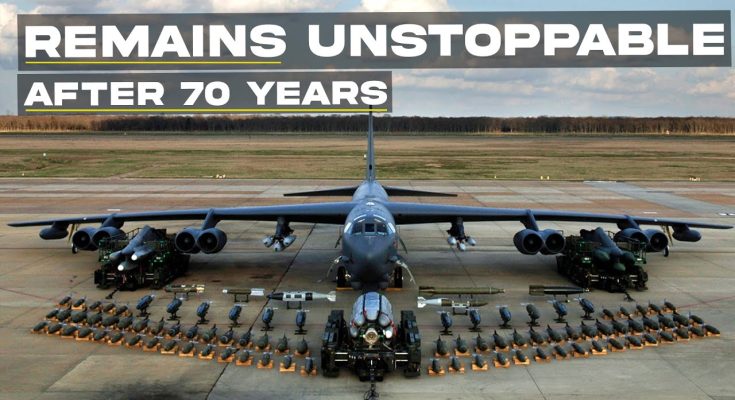The Boeing B-52 Stratofortress, a name synonymous with long-range, strategic bombing, has proven itself to be an unstoppable force in the world of military aviation for more than 70 years. Initially introduced in 1955, the B-52 was designed during the Cold War to carry out nuclear deterrence missions and provide the U.S. Air Force with a heavy bomber capable of striking anywhere in the world. Today, the B-52 remains an iconic and indispensable part of the U.S. Air Force’s fleet, with its resilience, adaptability, and unparalleled longevity. Despite its age, the B-52 continues to dominate the skies and maintain relevance in modern warfare, and here’s why.
Enduring Design and Reliability
One of the primary reasons the B-52 has withstood the test of time is its exceptional design. Built with simplicity and durability in mind, the aircraft was designed to be easy to maintain and operate, which has contributed to its incredible longevity. Its large, robust airframe and powerful engines have been able to withstand modifications and upgrades, allowing the B-52 to remain a relevant and effective tool for decades.
Its ability to endure and perform in diverse environments—whether flying at high altitudes for long distances or conducting low-level, precision bombing runs—has made it versatile in various operational settings. With a range of over 8,000 miles without refueling, the B-52 can project power across the globe, fulfilling its mission of delivering both conventional and nuclear payloads.
Constant Upgrades and Modernization
Another key reason the B-52 remains unstoppable is its continuous upgrades. While the B-52’s airframe has remained largely unchanged, the technology and systems onboard have undergone constant modernization. In the past few decades, the B-52 has received extensive upgrades to its avionics, weapons systems, and engines, ensuring that it stays relevant in the modern battlefield.
For example, the aircraft’s radar, navigation, and communications systems have all been upgraded to meet the demands of contemporary warfare. Its ability to carry modern precision-guided munitions (PGMs), including smart bombs and cruise missiles, has transformed the B-52 from a traditional “strategic bomber” into a highly capable multi-role platform. Additionally, the B-52’s crew systems have been updated, including improved flight decks with modern navigation and targeting systems, ensuring the aircraft can perform effectively in contested environments.
In 2021, the B-52 received an upgrade to its engine program, replacing the old TF33 engines with more modern and fuel-efficient engines. This will extend the aircraft’s life into the 2050s, ensuring it remains an operational asset for decades to come.
Versatility and Multi-role Capability
The B-52’s versatility is another reason it continues to be an essential asset for the U.S. Air Force. Although it was originally designed as a strategic nuclear bomber, the B-52 has evolved into a multi-role aircraft capable of carrying out a wide range of missions, including conventional bombing, maritime patrol, and close air support. Its ability to carry both nuclear and conventional weapons makes it uniquely suited for a variety of conflict scenarios.
Additionally, the B-52 can carry a diverse payload, ranging from gravity bombs and cruise missiles to precision-guided munitions, giving it the ability to strike at a wide range of targets. This flexibility allows it to support a wide array of mission types, from large-scale strategic strikes to precision attacks against specific enemy assets.
Global Reach and Deterrence
The B-52’s global reach and its role in nuclear deterrence remain central to its enduring relevance. As part of the U.S. nuclear triad, the B-52 provides a flexible, survivable, and effective second-strike capability. Its ability to carry nuclear weapons and its long range make it a powerful tool in maintaining global deterrence, sending a message of strength and readiness to adversaries.
The B-52 also plays a crucial role in global power projection, allowing the United States to maintain a presence in any conflict zone. Whether patrolling the Middle East, participating in exercises in the Indo-Pacific, or flying over Europe, the B-52 is a symbol of American military dominance and preparedness.
The “Unstoppable” Legacy
Even though the B-52 is over 70 years old, it remains an essential asset to the U.S. military. Its unparalleled longevity and consistent relevance in the face of evolving technological challenges have made it an irreplaceable part of the Air Force’s arsenal. Through continuous upgrades, its ability to evolve with the times ensures that the B-52 can perform its role for many more years.
As long as it continues to provide unmatched global reach, versatility, and survivability, the B-52 Stratofortress will remain an unstoppable force in modern warfare. With its status as a symbol of military power, its impressive capability to adapt, and its unmatched operational history, the B-52 will undoubtedly continue to serve as a cornerstone of U.S. military aviation for decades to come.



